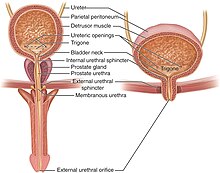
Marsupials are a diverse group of mammals belonging to the infraclass Marsupialia. They are natively found in Australasia, Wallacea, and the Americas. One of the defining features of marsupials is their unique reproductive strategy, where the young are born in a relatively undeveloped state and then nurtured within a pouch on their mother's abdomen.
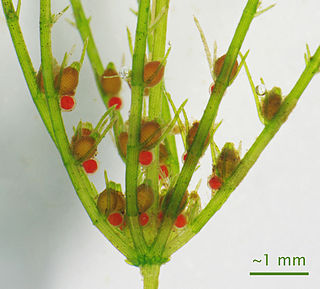
A sex organ, also known as a reproductive organ, is a part of an organism that is involved in sexual reproduction. Sex organs constitute the primary sex characteristics of an organism. Sex organs are responsible for producing and transporting gametes, as well as facilitating fertilization and supporting the development and birth of offspring. Sex organs are found in many species of animals and plants, with their features varying depending on the species.

The uterus or womb is the organ in the reproductive system of most female mammals, including humans, that accommodates the embryonic and fetal development of one or more fertilized eggs until birth. The uterus is a hormone-responsive sex organ that contains glands in its lining that secrete uterine milk for embryonic nourishment.
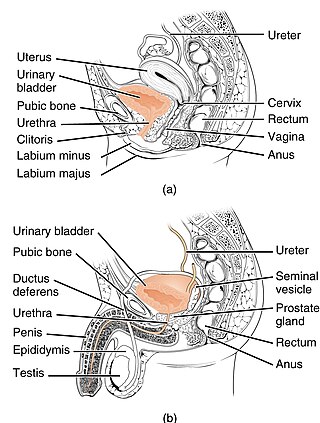
The urethra is the tube that connects the urinary bladder to the urinary meatus, through which placental mammals urinate and ejaculate. In non-mammalian vertebrates, the urethra also transports semen but is separate from the urinary tract.
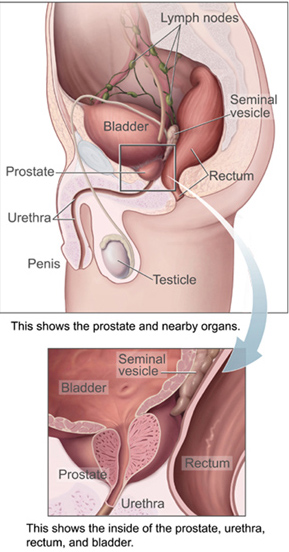
The prostate is an accessory gland of the male reproductive system and a muscle-driven mechanical switch between urination and ejaculation. It is found in all male mammals. It differs between species anatomically, chemically, and physiologically. Anatomically, the prostate is found below the bladder, with the urethra passing through it. It is described in gross anatomy as consisting of lobes and in microanatomy by zone. It is surrounded by an elastic, fibromuscular capsule and contains glandular tissue, as well as connective tissue.

The bulbourethral glands or Cowper's glands are two small exocrine and accessory glands in the reproductive system of many male mammals. They are homologous to Bartholin's glands in females. The bulbourethral glands are responsible for producing a pre-ejaculate fluid called Cowper's fluid, which is secreted during sexual arousal, neutralizing the acidity of the urethra in preparation for the passage of sperm cells. The paired glands are found adjacent to the urethra just below the prostate, seen best by screening (medicine) MRI as a tool in preventative healthcare in males. Screening MRI may be performed when there is a positive prostate-specific antigen on basic laboratory tests. Prostate cancer is the second-most common cause of cancer-related mortality in males in the USA.
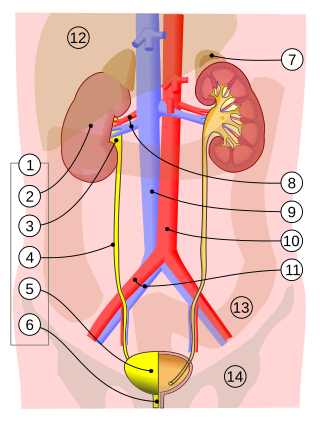
The ureters are tubes composed of smooth muscle that transport urine from the kidneys to the urinary bladder. In an adult human, the ureters typically measure 20 to 30 centimeters in length and about 3 to 4 millimeters in diameter. They are lined with urothelial cells, a form of transitional epithelium, and feature an extra layer of smooth muscle in the lower third to aid in peristalsis. The ureters can be affected by a number of diseases, including urinary tract infections and kidney stone. Stenosis is when a ureter is narrowed, due to for example chronic inflammation. Congenital abnormalities that affect the ureters can include the development of two ureters on the same side or abnormally placed ureters. Additionally, reflux of urine from the bladder back up the ureters is a condition commonly seen in children.

The seminal vesicles are a pair of convoluted tubular accessory glands that lie behind the urinary bladder of male mammals. They secrete fluid that largely composes the semen.

The urogenital sinus is a body part of a human or other placental only present in the development of the urinary and reproductive organs. It is the ventral part of the cloaca, formed after the cloaca separates from the anal canal during the fourth to seventh weeks of development.

A cloaca, pl.: cloacae, or vent, is the rear orifice that serves as the only opening for the digestive (rectum), reproductive, and urinary tracts of many vertebrate animals. All amphibians, reptiles, birds, and a few mammals have this orifice, from which they excrete both urine and feces; this is in contrast to most placental mammals, which have separate orifices for evacuation and reproduction. Excretory openings with analogous purpose in some invertebrates are also sometimes called cloacae. Mating through the cloaca is called cloacal copulation and cloacal kissing.

The genitourinary system, or urogenital system, are the sex organs of the reproductive system and the organs of the urinary system. These are grouped together because of their proximity to each other, their common embryological origin and the use of common pathways. Because of this, the systems are sometimes imaged together. In placental mammals, the male urethra goes through and opens into the penis while the female urethra and vagina empty through the vulva.
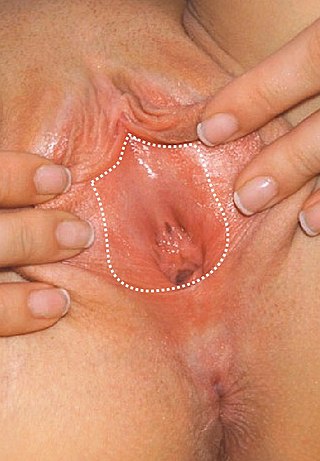
The vulval vestibule is the part of the vulva between the labia minora. At the innermost part are the vaginal introitus and urinary meatus. The Bartholin's and Skene's glands each have two openings to the vestibule on the inside. The outer edge, marked by a coloration difference in the tissues, is called Hart's line, named after David Berry Hart.
The development of the reproductive system is the part of embryonic growth that results in the sex organs and contributes to sexual differentiation. Due to its large overlap with development of the urinary system, the two systems are typically described together as the genitourinary system.
An extreme environment is a habitat that is considered very hard to survive in due to its considerably extreme conditions such as temperature, accessibility to different energy sources or under high pressure. For an area to be considered an extreme environment, it must contain certain conditions and aspects that are considered very hard for other life forms to survive. Pressure conditions may be extremely high or low; high or low content of oxygen or carbon dioxide in the atmosphere; high levels of radiation, acidity, or alkalinity; absence of water; water containing a high concentration of salt; the presence of sulphur, petroleum, and other toxic substances.

A penis is a male sex organ that is used to inseminate female or hermaphrodite animals during copulation. Such organs occur in both vertebrates and invertebrates, including humans, but not in all male animals.
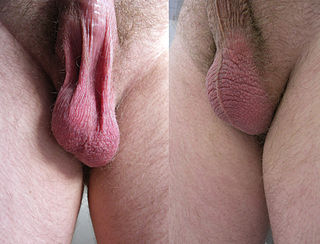
In most terrestrial mammals, the scrotum or scrotal sac is a part of the external male genitalia located at the base of the penis. It consists of a sac of skin containing the external spermatic fascia, testicles, epididymides, and vasa deferentia. The scrotum will usually tighten when exposed to cold temperatures.
The reproductive system of an organism, also known as the genital system, is the biological system made up of all the anatomical organs involved in sexual reproduction. Many non-living substances such as fluids, hormones, and pheromones are also important accessories to the reproductive system. Unlike most organ systems, the sexes of differentiated species often have significant differences. These differences allow for a combination of genetic material between two individuals, which allows for the possibility of greater genetic fitness of the offspring.

Monotremes are mammals of the order Monotremata. They are the only group of living mammals that lay eggs, rather than bearing live young. The extant monotreme species are the platypus and the four species of echidnas. Monotremes are typified by structural differences in their brains, jaws, digestive tract, reproductive tract, and other body parts, compared to the more common mammalian types. Although they are different from almost all mammals in that they lay eggs, like all mammals, the female monotremes nurse their young with milk.

Male accessory glands (MAG) are the seminal vesicles, prostate gland, and the bulbourethral glands. These glands are found only in mammals. In insects, male accessory glands produce products that mix with the sperm to protect and preserve them, including seminal fluid proteins. Some insecticides can induce an increase in the protein content of the male accessory glands of certain types of insects. This has the unintended effect of increasing the number of offspring they produce.
The kidneys are a pair of organs of the excretory system in vertebrates, which maintain the balance of water and electrolytes in the body (osmoregulation), filter the blood, remove metabolic waste products, and, in many vertebrates, also produce hormones and maintain blood pressure. In healthy vertebrates, the kidneys maintain homeostasis of extracellular fluid in the body. When the blood is being filtered, the kidneys form urine, which consists of water and excess or unnecessary substances, the urine is then excreted from the body through other organs, which in vertebrates, depending on the species, may include the ureter, urinary bladder, cloaca, and urethra.
